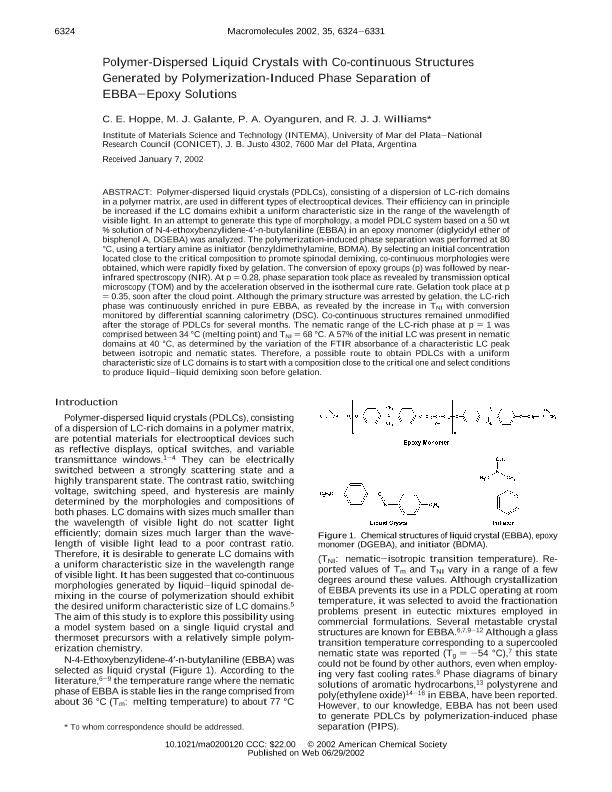Artículo
Polymer-Dispersed Liquid Crystals with Co-continuous Structures Generated by Polymerization-Induced Phase Separation of EBBA-Epoxy Solutions
Hoppe, Cristina Elena ; Galante, Maria Jose
; Galante, Maria Jose ; Oyanguren, Patricia Angelica
; Oyanguren, Patricia Angelica ; Williams, Roberto Juan Jose
; Williams, Roberto Juan Jose
 ; Galante, Maria Jose
; Galante, Maria Jose ; Oyanguren, Patricia Angelica
; Oyanguren, Patricia Angelica ; Williams, Roberto Juan Jose
; Williams, Roberto Juan Jose
Fecha de publicación:
07/2002
Editorial:
American Chemical Society
Revista:
Macromolecules
ISSN:
0024-9297
Idioma:
Inglés
Tipo de recurso:
Artículo publicado
Clasificación temática:
Resumen
Polymer-dispersed liquid crystals (PDLCs), consisting of a dispersion of LC-rich domains in a polymer matrix, are used in different types of electrooptical devices. Their efficiency can in principle be increased if the LC domains exhibit a uniform characteristic size in the range of the wavelength of visible light. In an attempt to generate this type of morphology, a model PDLC system based on a 50 wt % solution of N-4-ethoxybenzylidene-4‘-n-butylaniline (EBBA) in an epoxy monomer (diglycidyl ether of bisphenol A, DGEBA) was analyzed. The polymerization-induced phase separation was performed at 80 °C, using a tertiary amine as initiator (benzyldimethylamine, BDMA). By selecting an initial concentration located close to the critical composition to promote spinodal demixing, co-continuous morphologies were obtained, which were rapidly fixed by gelation. The conversion of epoxy groups (p) was followed by near-infrared spectroscopy (NIR). At p = 0.28, phase separation took place as revealed by transmission optical microscopy (TOM) and by the acceleration observed in the isothermal cure rate. Gelation took place at p = 0.35, soon after the cloud point. Although the primary structure was arrested by gelation, the LC-rich phase was continuously enriched in pure EBBA, as revealed by the increase in TNI with conversion monitored by differential scanning calorimetry (DSC). Co-continuous structures remained unmodified after the storage of PDLCs for several months. The nematic range of the LC-rich phase at p = 1 was comprised between 34 °C (melting point) and TNI = 68 °C. A 57% of the initial LC was present in nematic domains at 40 °C, as determined by the variation of the FTIR absorbance of a characteristic LC peak between isotropic and nematic states. Therefore, a possible route to obtain PDLCs with a uniform characteristic size of LC domains is to start with a composition close to the critical one and select conditions to produce liquid−liquid demixing soon before gelation.
Palabras clave:
Pdlc
,
Epoxy
,
Polymerization Induced Phase Separation
Archivos asociados
Licencia
Identificadores
Colecciones
Articulos(INTEMA)
Articulos de INST.DE INV.EN CIENCIA Y TECNOL.MATERIALES (I)
Articulos de INST.DE INV.EN CIENCIA Y TECNOL.MATERIALES (I)
Citación
Hoppe, Cristina Elena; Galante, Maria Jose; Oyanguren, Patricia Angelica; Williams, Roberto Juan Jose; Polymer-Dispersed Liquid Crystals with Co-continuous Structures Generated by Polymerization-Induced Phase Separation of EBBA-Epoxy Solutions; American Chemical Society; Macromolecules; 35; 16; 7-2002; 6324-6331
Compartir
Altmétricas



